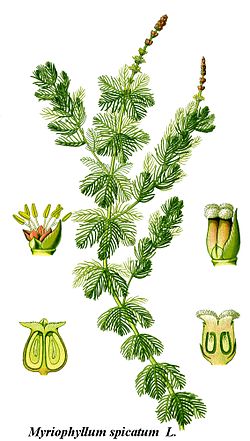History
Historically, the Haloragaceae included many disparate genera, since segregated. A major circumscription was carried out by Schindler in 1905, dividing the "Halorrhagaceae" into two subfamilies (Halorrhagoideae and Gunneroideae) and the former into two tribes (Halorrhageae and Myriophylleae), with a total of seven genera. He removed some of the disparate genera and merged Gonocarpus and Meionectes into Haloragis. This classification long remained the standard till Shaw (1966) removed Gunnera (into its own family Gunneraceae, within the order Gunnerales), the sole genus in Gunneroideae, leaving six genera. This situation remained until the monograph of Orchard (1975). Orchard restored Gonocarpus and split Haloragodendron from Haloragis, leaving 8 genera.
List of genera, habitat, distribution (Number of species)
- Terrestrial
- Semiaquatic
- Aquatic
Molecular era
A molecular study resolved the infrafamilial relationships among the genera, resulting in some taxonomic revision, including redistribution of species. In addition, Meionectes was reinstated, separating two species from Haloragis and creating a new monotypic genus, Trihaloragis by segregating Gonocarpus hexandrus. Consequently, the number of genera is increased to ten, with the addition of:
- Meionectes R.Br. (2)
- TrihaloragisMoody & Les (1)
Glischrocaryon-Haloragodendron is resolved as the basal node, sister to the remaining family. While monophyly of this group is well supported, monophyly of the two separate genera is less well supported, and suggests some paraphyly. Thus the generic limits remain unresolved.
A subsequent, more detailed study of Myriophyllum demonstrated that the monotypic genus Meziella was embedded within it, leading to its submersion within the former as Myriophyllum subgenus Meziella, thereby reducing the number of genera within the family to 9.





